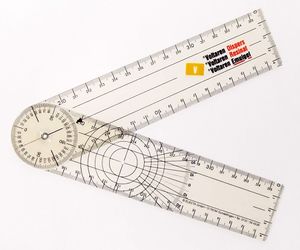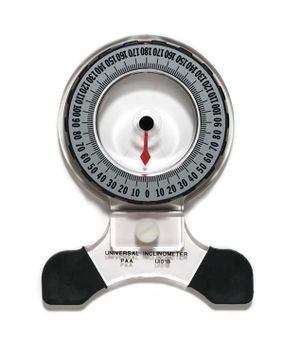Goniometry: Difference between revisions
No edit summary |
m (Naomi O'Reilly moved page Goniometer to Goniometry) |
(No difference)
| |
Revision as of 23:28, 13 June 2023
Original Editor - The Open Physio project.
Top Contributors - Innocent Abugu, Rachael Lowe, Chrysolite Jyothi Kommu, Admin, Naomi O'Reilly, Uchechukwu Chukwuemeka, Sonal Joshi, Lucinda hampton, WikiSysop, Claire Knott and Redisha Jakibanjar
Introduction[edit | edit source]
A goniometer is an instrument that measures the available range of motion at a joint. The art and science of measuring the joint ranges in each plane of the joint are called goniometry[1].
To measure the range of motion physical therapists most commonly use a goniometer.
If a patient or client is suffering from reduced range of motion in a particular joint, the therapist can use a goniometer to assess what the range of motion is at the initial assessment, and then make sure the intervention is working by using the goniometer in subsequent sessions.
Types of Goniometers[edit | edit source]
Of all the types, a universal goniometer is most widely used.
- Universal Goniometer (Figure.1)
- Comes in two forms: short arm and long arm.
- The short arm goniometer is used for smaller joints like the wrist, elbow, or ankle,
- The long arm goniometers are more accurate for joints with long levers like the knee and hip joints.
- Gravity Goniometer/Inclinometer (Figure.2)
- One arm has a weighted pointer that remains vertical under the influence of gravity. (Figure.2)
- Software/Smartphone-based Goniometer:
- A smartphone as a digital goniometer has several benefits like availability, ease of measurement, application-based tracking of measurements, and one-hand use. These applications use the accelerometers in phones to calculate the joint angles.
- Arthrodial Goniometer:
- Ideal for measuring cervical rotation, anteroposterior flexion, and lateral flexion of the cervical spine.
- Twin Axis Electrogoniometer:
- The inter-rater and intra-rater reliability of the electrogoniometer is higher than the universal goniometer but challenging to apply in patients' clinical evaluation, hence used more often for research purposes[1]
Validity and Reliability[edit | edit source]
There is some question as to whether or not a goniometer is a sufficiently valid and reliable instrument to determine whether an intervention has been effective[2]. Some research argues that the reliability of the measurement gotten from a goniometer depends on the type used[3][4] while some did not see any significant difference between some instruments[5][6]
Goniometry Technique[edit | edit source]
It is necessary that a single notation system is used in goniometry. The neutral zero method (0 to 180- degree system) is the most widely used method. The same goniometer should always be used to reduce the chances of instrumental error.
- Position and stabilise the joint correctly.
- Move a body part through its appropriate range of motion (ROM).
- Determine the joint's end of the range of motion and end-feel.
- Palpate the appropriate bony landmarks.
- Align the goniometer with the landmarks.
- Read the measuring instrument properly
- Record measurements correctly (both active and passive range of motion should be measured and recorded respectively).[1]
- The range of motion of each joint should be measured in isolation, to avoid trick movement (simultaneous movement of another joint) and muscle insufficiency which may alter the reading.
Procedures[edit | edit source]
- Ankle (Subtalar) Eversion
- Ankle (Subtalar) Inversion
- Ankle (Talocrural) Dorsiflexion
- Ankle (Talocrural) Plantarflexion
- Elbow Extension
- Elbow Flexion
- Forearm Pronation
- Forearm Supination
- Hip Abduction
- Hip Adduction
- Hip Extension
- Hip Flexion
- Hip External Rotation
- Hip Internal Rotation
- Knee Extension
- Knee Flexion
- Shoulder Abduction
- Shoulder Flexion
- Shoulder Horizontal Abduction
- Shoulder Internal and External Rotation
- Wrist Extension
- Wrist Flexion
- Wrist Radial Deviation
- Wrist Ulnar Deviation
References[edit | edit source]
- ↑ 1.0 1.1 1.2 Goniometer.Viraj N. Gandbhir, Bruno Cunha,In: StatPearls. Treasure Island (FL): StatPearls Publishing; 2020 Jan.2020 Jun 12.Pubmed.gov. National Library of Medicine.National Centre for Biotechnology Information.
- ↑ Goniometer. (2008, August 30). In Wikipedia, The Free Encyclopedia. Retrieved 11:12, September 14, 2008, from http://en.wikipedia.org/wiki/Goniometer.
- ↑ Milanese S et al. Reliability and concurrent validity of knee angle measurement: Smart phone app versus universal goniometer used by experienced and novice clinicians. Manual Therapy, 2014; 5: 1–6.
- ↑ Jones A, Sealey R, Crowe M, Gordon S. Concurrent validity and reliability of the simple goniometer iPhone app compared with the universal goniometer. Physiotherapy Theory and Practice. 2014;30 (7): 512–516.
- ↑ Mourcou Q, Fleury A, Diot B, Franco C, Vuillerme N. Mobile Phone-Based Joint Angle Measurement for Functional Assessment and Rehabilitation of Proprioception.Biomed Res Int. 2015; doi: 10.1155/2015/328142
- ↑ Ockendon M, Gilbert RE. Validation of a Novel Smartphone Accelerometer-Based Knee Goniometer. Journal of Knee Surg. 2012;25:341–346.








